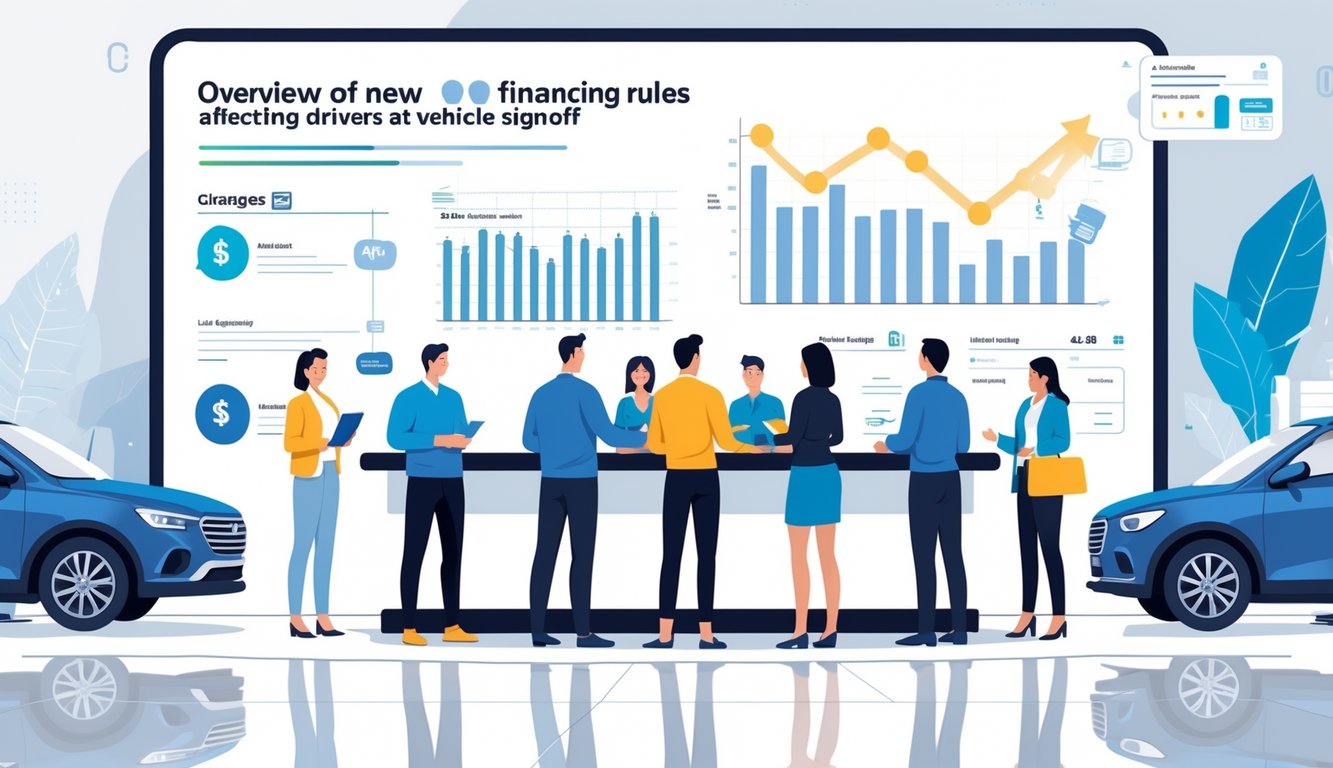
Every single time I’m stuck squinting at a pile of finance forms, I swear my brain just checks out at those “amount due today” lines. Is it just me, or do those numbers always look a little off? Anyway, surprise—regulators had to meddle again. So if you’re about to sign for a new car? The “what you owe at signoff” bit just got a total remix. Not just more paperwork, either. Supposedly, these new federal auto financing rules are supposed to make costs less mysterious and save billions (FTC claims $3.4 billion in savings), but honestly, who’s pocketing all that? Last week, a client of mine didn’t even notice her drive-off payment dropped by fifty bucks until her third signature. Dealers can’t just sneak in “junk” fees behind the doc charge anymore, which is… progress? Maybe?
And now salespeople have to say stuff like “that’s the out-the-door price” with this weird, forced confidence, like they’re about to get called out for cheating on a quiz. Even the old pros in finance are sweating, because screwing up the signoff numbers means real fines now. I keep wondering if my calculator’s finally obsolete, or if all this “transparency” just means we get to the haggling part faster—assuming the printer isn’t jammed for the third time in an hour.
People keep yapping about the 20% rule, like it’s some sacred dealership code (yeah, USA Today says to watch for hidden taxes and fees anyway). My neighbor thought leasing was safer, but now she’s just as lost as I am. And state laws? Creepier than you think. Are these changes for everyone, or just for that guy behind me in line with the iced coffee and the thousand-yard stare?
Overview of the New Financing Rules

So, banks are tossing out new forms every week, and suddenly your APR isn’t what you budgeted for. Legalese sneaks into every corner of the loan paperwork, and I’m always convinced I missed some memo. Signoff costs? Never actually fixed, not really. “Disclosure harmonization” keeps getting thrown around by experts, which I guess is supposed to mean something, but mostly just makes me hungry. If your financing agreement feels like a puzzle, trust me, you’re not the only one jamming the wrong pieces together.
Key Changes Introduced
Okay, so now there’s this required pre-signoff breakdown: at least two F&I managers told me drivers get a clear, item-by-item table with every up-front charge—doc fees, add-on insurance, all of it mashed together next to the principal. They even had to update those “agreed upon at delivery” lines, so now there are disclaimers you can actually spot… except, sometimes, not. Mortgage rules got a similar overhaul, so I guess the auto industry had to play catch-up. I’m shocked these forms don’t come with a manual and a juice box.
Interest on auto loans? Now it’s got to be spelled out as both a dollar amount and the APR. Sure, maybe redundant, but at least it stops salespeople from hiding behind percentages nobody understands. I saw a buyer almost walk out after realizing her “discounted” extended warranty added 9% to her upfront costs. If some dealer tries to gloss over the “signoff reconciliation” clause, just whip out a screenshot of the new compliance PDF and watch them sweat.
Impact on the Auto Financing Industry
Finance managers are losing it over the timelines. Deals that used to close by lunch now drag into late afternoon because e-signature platforms keep choking on all the new forms. One “Compliance Resource” rep said their call volume doubled in June. Dealerships can get whacked with penalties for missing a single box in the disclosure maze. If your lender seems nervous, they probably are—fines for wrong interest rates shot up 25% last quarter.
Drivers do get a tiny win, though. Lenders have to give you real amortization schedules up front, so there’s less last-minute math panic, especially on leases where the residual value is basically a quantum state—there and not there. The National Auto Finance Association sent out a memo (pretty sure nobody read it) telling brokers to stop stalling on the final review. Buyers keep skipping it anyway, then act shocked when they owe sales tax on the protection plan.
Oh, and ignore the myth about rounding your down payment to the nearest $100 helping your credit. Some Honda guy in Ohio told me that last week, right after his computer crashed mid-loan. Just read the disclosures and grab a printout—who knows when the rules will flip again.
How the New Rules Affect Drivers’ Financial Commitments
So, yeah, at signoff, drivers aren’t just getting hit with random fees—they’re dealing with ultra-specific down payment minimums, dense fee disclosures, and those surprise credit checks that seem to pop up just for fun. It’s not just the sticker price or some dealership “bonus.” Real people—like me—are getting smacked by changes that don’t even work the same for everyone. It’s a mess.
Changes to What Drivers Owe at Signoff
Digging through paperwork this week, I found new non-negotiable doc fees, one line bolded so even the sleep-deprived can’t miss it. No more hiding extras in the fine print. Transport Canada folks compared these new upfront cost disclosures to credit card reforms, but who actually reads those? Still, at least the new policy blocks hidden surcharges at closing, so you pay a more obvious sum—like a $550 “admin” fee—along with taxes and titling. Not just the old “surprise!” at the end.
Loan terms? Now you’re stuck with rigid formulas. Used cars? 60 months, max. No more creative math to hide high rates or sneak “extras” into the total. And if you think your trade-in is going to save you more cash up front, sorry—only the actual agreed value cuts the principal. I asked a finance manager if this helps or just boxes us in. She just shrugged: “Well, at least the math’s right there… even if you hate it.”
Differences for New and Returning Buyers
First-time buyers are getting hit with stricter income checks before they can even sniff at incentives. If you’re trading up or coming off a lease, your residuals are suddenly based on less generous schedules—stuff that didn’t even exist last year. And yeah, mortgage reforms let first-timers get 30-year amortizations for homes, but for cars? Forget it. Still stuck at 20-25% down for some brackets, and if your credit score drops by a hair, you’re out.
Returning buyers, especially those refinancing, now have to deal with “switch lender at renewal” rules, just like the new mortgage stuff in Canada. Sounds simple, but it means you actually have to read the whole amortization schedule before signing. Lenders won’t overlook little credit dings just because you’re a “regular.” I’ve heard from a couple of folks who said they never saw their actual, final signoff costs line-by-line until this year. Some are relieved; me? It’s just more homework, but maybe less chance of getting blindsided—if I stay awake long enough to read it all.
